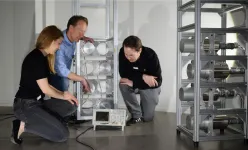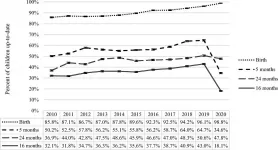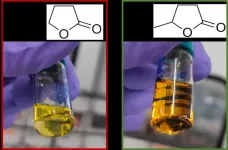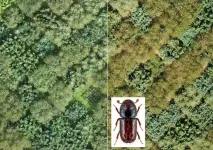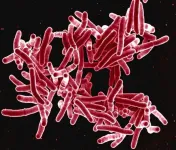(Press-News.org) In new research, Texas A&M University scientists have for the first time revealed a single microscopic defect called a "twin" in a soft-block copolymer using an advanced electron microscopy technique. This defect may be exploited in the future to create materials with novel acoustic and photonic properties.
"This defect is like a black swan -- something special going on that isn't typical," said Dr. Edwin Thomas, professor in the Department of Materials Science and Engineering. "Although we chose a certain polymer for our study, I think the twin defect will be fairly universal across a bunch of similar soft matter systems, like oils, surfactants, biological materials and natural polymers. Therefore, our findings will be valuable to diverse research across the soft matter field."
The results of the study are detailed in the Proceedings of the National Academy of Sciences (PNAS).
Materials can be broadly classified as hard or soft matter. Hard materials, like metal alloys and ceramics, generally have a very regular and symmetric arrangement of atoms. Further, in hard matter, ordered groups of atoms arrange themselves into nanoscopic building blocks, called unit cells. Typically, these unit cells are comprised of only a few atoms and stack together to form the periodic crystal. Soft matter can also form crystals consisting of unit cells, but now the periodic pattern is not at the atomic level; it occurs at a much larger scale from assemblies of large molecules.
In particular, for an A-B diblock copolymer, a type of soft matter, the periodic molecular motif comprises of two linked chains: one chain of A units and one chain of B units. Each chain, called a block, has thousands of units linked together and a soft crystal forms by selective aggregation of the A units into domains and B units into domains that form huge unit cells compared to hard matter.
Another notable difference between soft and hard crystals is that structural defects have been much more extensively studied in hard matter. These imperfections can occur at a single atomic location within material, called a point defect. For example, point defects in the periodic arrangement of carbon atoms in a diamond due to nitrogen impurities create the exquisite "canary" yellow diamond. In addition, imperfections in crystals can be elongated as a line defect or spread across an area as a surface defect.
By and large, defects within hard materials have been extensively investigated using advanced electron imaging techniques. But in order to be able to locate and identify defects in their block copolymer soft crystals, Thomas and his colleagues used a new technique called slice-and-view scanning electron microscopy. This method allowed the researchers to use a fine ion beam to trim off a very thin slice of the soft material, then they used an electron beam to image the surface below the slice, then slice again, image again, over and over. These slices were then digitally stacked together to get a 3D view.
For their analysis, they investigated a diblock copolymer made of a polystyrene block and a polydimethylsiloxane block. At the microscopic level, a unit cell of this material exhibits a spatial pattern of the so-called "double gyroid" shape, a complex, periodic structure consisting of two intertwined molecular networks of which one has a left-handed rotation and the other, a right-handed rotation.
While the researchers were not actively looking for any particular defect in the material, the advanced imaging technique uncovered a surface defect, called a twin boundary. At either side of the twin juncture, the molecular networks abruptly transformed their handedness.
"I like to call this defect a topological mirror, and it's a really neat effect," said Thomas. "When you have a twin boundary, it's like looking at a reflection into a mirror, as each network crosses the boundary, the networks switch handedness, right becomes left and vice versa."
The researcher added that the consequences of having a twin boundary in a periodic structure that does not by itself have any inherent mirror symmetry could induce novel optical and acoustic properties that open new doors in materials engineering and technology.
"In biology, we know that even a single defect in DNA, a mutation, can cause a disease or some other observable change in an organism. In our study, we show a single twin defect in a double gyroid material," said Thomas. "Future research will explore to see whether there's something special about the presence of an isolated mirror plane in a structure, which otherwise has no mirror symmetry."
INFORMATION:
Other contributors to this research include Xueyan Feng from the materials sciences and engineering department and Mujin Zhuo and Hua Guo from Rice University.
This research was support by a grant from the National Science Foundation.
Journal link: https://www.pnas.org/content/118/12/e2018977118
YouTube link: https://www.youtube.com/watch?v=at26Vg_P_TE
Caption: The double gyroid shape of the deblock copolymer consists of two intertwined molecular networks of which one has a left-handed rotation (blue) and the other, a right-handed rotation (red).
Credit: Courtesy of Dr. Edwin Thomas/Texas A&M University College of Engineering
Scanning technology aimed at detecting small amounts of nuclear materials was unveiled by scientists in Sweden today, with the hope of preventing acts of nuclear terrorism.
Bo Cederwall, a professor of physics at KTH Royal Institute of Technology, says the technology can be used in airports and seaports for routine inspection of passengers and goods. The research is published and featured in the journals Science Advances and Science, respectively.
A form of tomography, the system enables quick 3D imaging of the source of neutron and gamma ray emissions from weapons-grade plutonium and other special nuclear materials, Cederwall says.
The so-called Neutron-Gamma Emission Tomography (NGET) system goes beyond the capabilities of existing radiation portal monitors, ...
Despite expert recommendations that children continue to get regularly scheduled vaccines during the pandemic, vaccination rates have decreased in several states.
A new study by researchers from the Texas A&M University School of Public Health and several other research institutions looked at childhood immunization rates in Texas to see what effect the COVID-19 pandemic may have had on childhood immunizations in 2020. In the study, led by public health doctoral student Tasmiah Nuzhath and published in the journal Vaccine, the researchers used data from a statewide immunization registry ...
May 19, 2021 - For patients with severe arthritis of the ankle, total ankle arthroplasty (TAA) provides better long-term function than ankle arthrodesis (AA), reports a study in The Journal of Bone & Joint Surgery. The journal is published in the Lippincott portfolio in partnership with Wolters Kluwer.
"Both established treatments for end-stage ankle arthritis are effective at pain relief and improved patient-reported outcomes," according to the research by Bruce Sangeorzan MD, and colleagues at the University of Washington and VA Puget Sound Health Care System. "However, it appears TAA leads to greater improvement in most patient-reported outcome measures at 48 months after surgery."
Study adds to evidence supporting TAA for ankle arthritis
End-stage ankle arthritis is characterized ...
The continued growth of wireless and cellular data traffic relies heavily on light waves. Microwave photonics is the field of technology that is dedicated to the distribution and processing of electrical information signals using optical means. Compared with traditional solutions based on electronics alone, microwave photonic systems can handle massive amounts of data. Therefore, microwave photonics has become increasingly important as part of 5G cellular networks and beyond. A primary task of microwave photonics is the realization of narrowband filters: the selection of specific data, at specific frequencies, out of immense volumes that are carried over light.
Many microwave photonic systems are built ...
Scientists at SPECIFIC Innovation and Knowledge Centre, Swansea University, have found a way to replace the toxic, unsustainable solvents currently needed to make the next generation of solar technology.
Printed carbon perovskite solar cells have been described as a likely front runner to the market because they are extremely efficient at converting light to electricity, cheap and easy to make.
A major barrier to the large-scale manufacture and commercialisation of these cells is the solvents used to control crystallisation of the perovskite during fabrication: this is because they are ...
ITHACA, N.Y. - For the first time, Cornell University researchers have developed a technique for studying the neuroscience of motor control in mice ¬- by focusing on a mouse's tongue when it licks a water spout.
The technique incorporates high-speed cameras and machine learning in a tractable experimental setup that opens the door for revealing mysteries of how the motor cortex works, understanding the neural basis of related disorders like Parkinson's disease, and informing robots.
"We now have an approach in a mouse where we can bring all the tools of modern neuroscience to bear on this really classic problem of motor control," said senior author Jesse Goldberg, associate professor of neurobiology and behavior.
The field of motor control neuroscience has made advancements ...
Updated Criteria Also Released for Legius Syndrome and Mosaic NF
NF2 and Schwannomatosis Diagnostic Criteria to Be Released Later This Year
The Children's Tumor Foundation (CTF) today announced the publication of updated diagnostic criteria for the genetic disorder neurofibromatosis type 1 (NF1) in Genetics in Medicine, the official journal of the American College of Medical Genetics and Genomics. The new publication is the result of an extensive, multi-year collaborative effort of over 90 leading neurofibromatosis (NF) experts from around the globe, and is aimed at improving the accuracy and earlier diagnosis of NF1 in patients, thus ultimately leading to improved care and quality of life for those patients. ...
Open up Scott Roy's Twitter bio and you'll see a simple but revealing sentence: "The more I learn the more I'm confused." Now the rest of the scientific world can share in his confusion. The San Francisco State University associate professor of Biology's most recent research, published earlier this month in one of the scientific world's most prestigious journals, catalogues a strange and confounding system of genes in a tiny rodent that scientists have ignored for decades.
"This is basically the weirdest sex chromosome system known to science," Roy said. "Nobody ordered this." But he's serving it anyway.
The owner of those chromosomes is the creeping vole, a burrowing rodent native to the Pacific Northwest. Scientists ...
In recent years, foresters have been able to observe it up close: First, prolonged drought weakens the trees, then bark beetles and other pests attack. While healthy trees keep the invaders away with resin, stressed ones are virtually defenseless. Freiburg scientist Sylvie Berthelot and her team of researchers from the Faculty of Environment and Natural Resources and the Faculty of Biology are studying the importance of tree diversity on bark beetle infestation. They are investigating whether the composition of tree species affects bark beetle feeding behavior. The team recently published their findings in the Journal of Ecology.
In a 1.1 hectare experimental set-up in Freiburg, six native deciduous and coniferous tree species from Europe and six deciduous and coniferous ...
SAN ANTONIO (May 19, 2021) -- Four months of multi-drug therapy that included rifapentine and moxifloxacin treated active tuberculosis (TB) as effectively as the standard six-month regimen in a multinational study, cutting treatment time by a third. Coauthors including Marc Weiner, MD, of The University of Texas Health Science Center at San Antonio, reported the findings May 6 in the New England Journal of Medicine.
"Shorter treatment would be easier for people to complete without missing doses, and ultimately may be cost-effective," said Dr. Weiner, associate professor in the health science center's Joe R. and Teresa Lozano END ...
